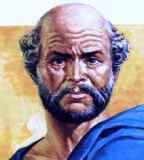More People of Greece
More Topic Categories
Related Destinations
Phidias (~-490 - ~-430)
 Phidias was a Greek sculptor, painter and architect who lived during the 5th century BC and is considered one of the most important sculptors of the Classical era.
Phidias was a Greek sculptor, painter and architect who lived during the 5th century BC and is considered one of the most important sculptors of the Classical era.He was born in Athens around 490 BC to a prominent Athenian family. From a young age, he turned to sculpting, studying under the Athenian sculptor Egias. His first sculpts started appearing around 465 BC, when the most powerful politician in Athens was Kimon, son of Miltiades and later main opponent of Pericles in politics. Phidias’ first sculpts were dedicated to the memory of the Greeks who fought against the Persians during the Battle of Marathon. In Delphi, Phidias constructed a bronze sculpture, depicting Apollo, Athena, various heroes from the battle as well as General Miltiades. He later sculpted Athena Promahos which was located within Acropolis.
After Kimon was ostracized and Pericles emerged to power, there begins the second, more mature stage of Phidias as a sculptor. Pericles appointed him the main renovator of the temples of Acropolis and Parthenon. All sculptures of the Parthenon were made by marble from Penteli Mountain and were decorated with metallic objects and colouring, and were considered incredible masterpieces of art. Phidias was probably responsible for the artistic creation and organization of the themes that would be depicted on the front, the frieze and the pediment of the Parthenon. Numerous sculptors and artists were involved in the creation of the sculptures, under Phidias’ command. The renovation of the Parthenon was completed in 432 BC. Phidias also created the famous gold-and-ivory statue of Athena Parthenos, of colossal size; unfortunately, it was probably destroyed during the fire that burned the inner temple during the 3rd century AD.
The amount of gold that Phidias used was the basis of his opponents’ attacks against him, accusing him of embezzlement. However, as Pericles had asked that the golden clothing of Athena be constructed in parts, Phidias managed to disassemble it and weigh it in front of the court, thus acquitting himself of all charges. Soon afterwards, he was accused of arrogance, because on the outer side of the shield of Athena, there was a depiction of Amazons and Athenians fighting, and two of the Athenian warriors resembled Pericles and himself. Phidias was arrested and found guilty. It is uncertain what happened afterwards; Plutarch mentions that Phidias died in prison, while another historian, Philochorus, says that Phidias left Athens before his arrest and moved to Olympia, where he had his workshop. His fate here was not better; once again, he was accused of embezzlement and died in prison. In 1958, an archeological dig on the supposed site of Phidias’ workshop brought to light a number of tools, ivory shards, as well as a jug with Phidias’ name inscribed on it.
Unfortunately, most of Phidias’ work has been lost or destroyed. However, many of his prototypes were copied in Rome, and these remain. It is evident, though, that Phidias was a great sculptor and is rightly considered the greatest Greek sculptor of antiquity.
See Also:
 Athens Photos
Athens Photos
 Santorini Photos
Santorini Photos
 Crete Photos
Crete Photos
 Meteora Photos
Meteora Photos
 Corfu Photos
Corfu Photos




